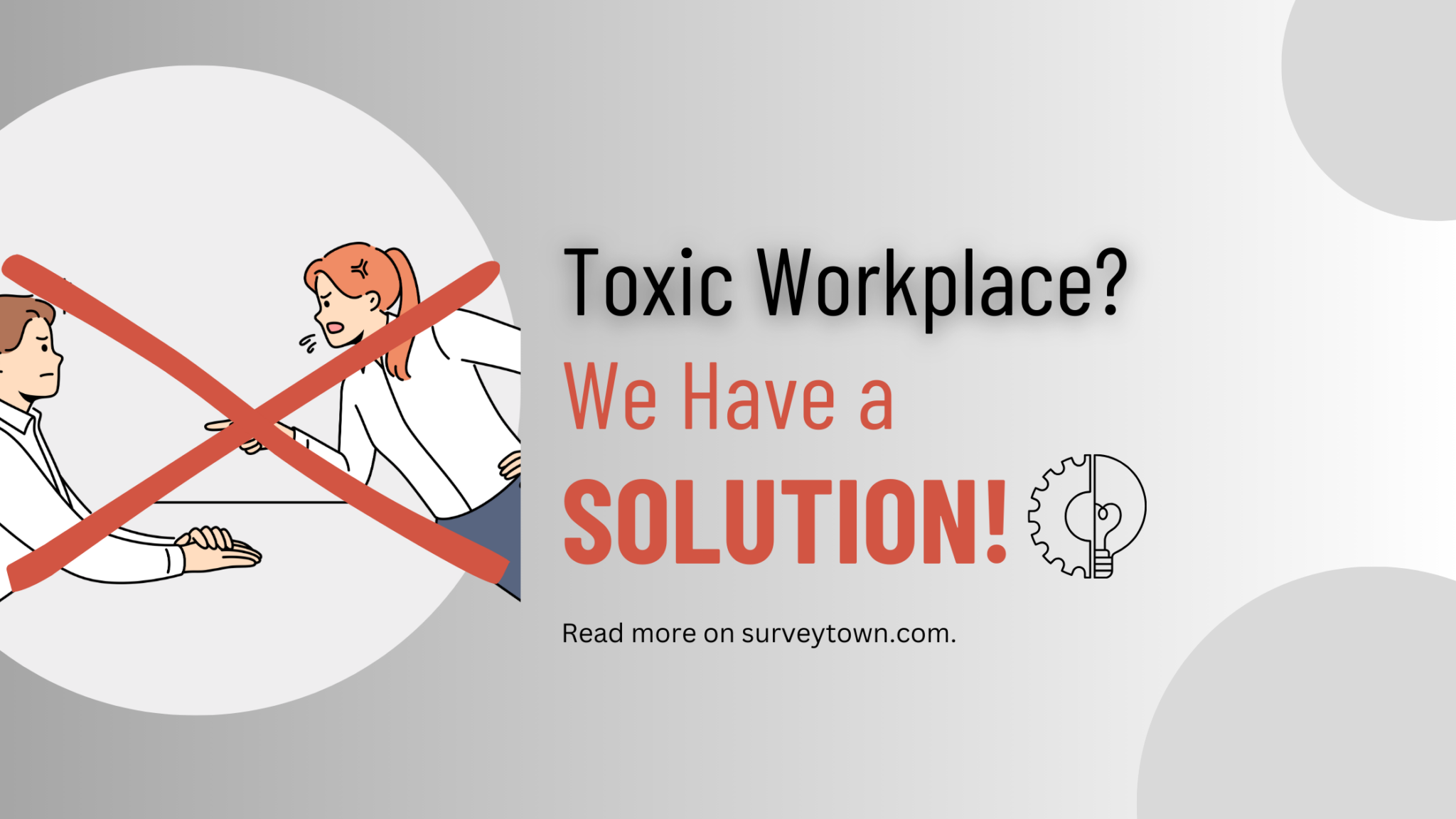Welcome to our blog, where we will discuss how to fix a toxic work environment and provide you with valuable tips on dealing with workplace toxicity. As experts in the field, we understand the detrimental effects that a toxic job environment can have on your mental and physical health. That’s why it is crucial to recognize the signs of toxicity and learn how to survive and thrive in such challenging situations. A toxic work environment is characterized by negative behaviors, a lack of support from colleagues or superiors, constant criticism, and an overall culture that hinders personal growth. Keep reading to discover all the signs and ways to fix the situation.
Check out this article to learn how to identify toxic job environments!
Unveiling the Secrets of a Toxic Work Environment
Welcome to this enlightening section, where we will delve into the depths of what truly constitutes a toxic work environment. Prepare yourself for expert analysis as we explore the telltale signs and symptoms that plague these detrimental workplaces while also shedding light on the profound impact they have on employees’ mental and physical well-being.
Defining Toxicity: Decoding the Anatomy of a Toxic Work Environment
A toxic work environment is far more than just an unpleasant place to spend your working hours; it’s an insidious breeding ground for stress, negativity, and mistreatment. Picture this – bullying, harassment, discrimination, excessive workload expectations, lack of support from management or colleagues, and poor communication all intertwine to create a hostile atmosphere that suffocates productivity and happiness.
The Warning Signs: Navigating Through Troubled Waters
In order to effectively navigate through treacherous waters, one must first recognize the warning signs that indicate a toxic workplace:
- Frequent conflicts among coworkers resemble stormy seas constantly brewing with tension.
- A high employee turnover rate acts as a red flag, signaling dissatisfaction within the ranks.
- Trust becomes scarce in environments where employees feel disconnected from their leaders.
- Constant criticism or belittlement erodes morale like relentless waves crashing against sturdy cliffs.
- Micromanagement stifles creativity and autonomy in decision-making processes.
- Excessive workloads coupled with unrealistic deadlines create overwhelming pressure akin to being caught in turbulent currents.
- Poor communication channels become whirlpools of misunderstandings and misinformation.
The Devastating Impact: When Storm Clouds Gather Overhead
The consequences of enduring a toxic work environment can be devastating for both mental and physical health. Imagine dark clouds looming overhead as stress levels soar uncontrollably. Anxiety disorders take root while depression symptoms cast shadows over once-vibrant lives. Sleep disturbances haunt exhausted minds, and job satisfaction dwindles like a flickering flame. Burnout syndrome engulfs individuals in emotional exhaustion, leaving them feeling depleted and defeated. The constant barrage of criticism or negative feedback chips away at self-esteem and self-confidence, leaving employees adrift in a sea of doubt.
It is crucial to recognize these warning signs early on so that we can chart a course toward healing and restoration. In the following sections, we will equip you with invaluable strategies for effectively dealing with the toxicity that may plague your work environment. Together, we will navigate through troubled waters toward brighter horizons.
Strategies to Cope With a Toxic Work Environment
Navigating a toxic work environment can be an arduous journey, but fear not! As experts in dealing with workplace toxicity, we are here to provide you with invaluable tips and tricks to help you not only survive but thrive amidst the chaos. Let’s dive right into it!
Manage Stress
Coping with stress is paramount when faced with a toxic work environment. Engaging in activities like exercise, meditation, or pursuing hobbies acts as a powerful antidote, alleviating anxiety and providing much-needed emotional release.
Prioritize Self-Care
Taking care of yourself should always be your top priority when dealing with workplace toxicity. Ensure you get ample sleep, nourish your body with nutritious meals, and indulge in activities that bring joy outside of the office walls.
Set Firm Boundaries
Establishing clear boundaries is crucial for safeguarding your well-being within a toxic workplace culture. Learn to assertively say no when necessary and avoid taking on additional responsibilities that may exacerbate stress levels.
Seek Support from Trusted Allies
Reach out to colleagues, friends, or family members who understand the challenges of working in such environments. Sharing experiences and emotions provides solace and validation during difficult times.
Embrace Mindfulness Practices
Incorporating mindfulness techniques into your daily routine can ground you amidst the turmoil of a toxic work environment. Take moments throughout the day to focus on your breath or engage in mindful activities such as walking or journaling.
Develop Personal Coping Mechanisms
Discover coping mechanisms tailored specifically to suit your needs when confronted with stressful situations at work. Deep breathing exercises, visualization techniques, or positive self-talk are just some examples that can empower you during trying times.

Seek Professional Guidance if Necessary
If the toxicity becomes overwhelming and starts significantly impacting your mental health, don’t hesitate to seek professional help from therapists or counselors specializing in workplace issues. They possess the expertise to guide you towards a healthier and happier work-life balance.
Remember, surviving and thriving in a toxic work environment requires resilience and perseverance. However, never forget that your well-being should always take precedence. By implementing these expert strategies, you’ll not only conquer the challenges but emerge stronger than ever before.
Taking Action: Reporting and Escalating Issues
When faced with a toxic work environment, it is crucial to take action and address the issues head-on. By reporting and escalating problems, you have the power to create positive change for yourself and your colleagues. Here are some expert tips on how to effectively deal with a toxic work environment:
- Document incidents: It is essential to keep a detailed record of any incidents or behaviors that contribute to the toxicity in your workplace. This documentation will serve as valuable evidence when reporting the issues.
- Follow company policies: Take the time to familiarize yourself with your company’s policies regarding workplace behavior and conflict resolution. Understanding these procedures will empower you when it comes time to report complaints or concerns.
- Report to HR or management: If you feel comfortable doing so, report the toxic behavior directly to Human Resources (HR) or your immediate supervisor/manager. Provide them with specific information about each incident, including dates, times, and individuals involved.
- Maintain professionalism: Despite any emotional distress caused by the toxic environment, it is important for you to remain professional and composed throughout this entire process.
- Consider anonymous reporting options: If fear of retaliation prevents you from disclosing your identity initially, explore whether there are anonymous reporting channels available within your organization that can protect your anonymity while still addressing the issue at hand.
- Know your legal rights: Educate yourself on employment laws that protect employees from hostile work environments, such as harassment or discrimination based on race, gender, religion, etc., depending on applicable legislation in your country/state/province.
- Seek external assistance if necessary: In case internal measures fail to resolve the issue satisfactorily or if you face retaliation after making a complaint internally, consult an employment lawyer specializing in workplace issues for guidance on how best to proceed legally.
Remember, taking action against a toxic work environment requires courage, but it can lead to positive change not only for yourself but also for future employees who may face similar challenges. By following these expert tips, you are empowering yourself and contributing to a healthier and more supportive workplace culture.
Seeking Help and Support
Dealing with a toxic work environment can be incredibly challenging, but remember that you don’t have to face it alone. Seeking help and support is crucial for your well-being and ability to navigate the situation effectively. In this section, we will explore when and how to seek professional assistance, the role of HR and management in addressing toxicity, as well as available resources and support groups.
Recognizing When To Seek Professional Help
Knowing when it’s time to reach out for professional help is essential in managing the impact of a toxic work environment on your mental health. Consider seeking assistance if:
- You constantly feel overwhelmed, anxious, or depressed due to your work environment.
- Your physical health starts deteriorating due to stress-related symptoms like headaches or insomnia.
- You notice changes in your behavior or relationships outside of work because of workplace toxicity.
- Self-help strategies are not effective in managing the emotional toll caused by the toxic environment.
The Role of HR and Management
Human Resources (HR) departments play a vital role in fostering a healthy work culture. Here’s what they can do:
- Establish clear policies against harassment, bullying, discrimination, or any other form of mistreatment.
- Encourage open communication channels where employees feel safe reporting issues without fear of retaliation.
- Conduct regular employee satisfaction surveys or anonymous feedback mechanisms to identify potential problems within the organization.
- Provide training programs on conflict resolution skills for both managers and employees.
Resources and Support Groups
There are several resources available that offer guidance and support for individuals dealing with a toxic work environment:
- Employee Assistance Programs (EAPs): Many companies provide EAPs that offer confidential counseling services for their employees.
- Professional therapists: Consider seeking therapy from licensed professionals who specialize in workplace issues or stress management techniques.
- Online forums: Joining online communities dedicated to discussing workplace toxicity can provide validation, advice from others who have experienced similar situations, and a sense of belonging.
- Support groups: Look for local support groups or organizations that focus on workplace issues. Connecting with others who have faced similar challenges can be empowering and provide valuable insights.
Remember, seeking help is not a sign of weakness but rather an act of self-care. It takes courage to acknowledge the impact a toxic work environment can have on your well-being and take steps toward finding support.
Exploring Other Opportunities
When faced with a toxic work environment, it’s crucial to prioritize your well-being and consider alternative options. If you constantly find yourself stressed and unhappy at your current job, it may be time to explore new employment opportunities. Here are some expert tips on how to navigate this process while still working:
- Evaluate your situation: Take a step back and assess whether leaving your current job is the best decision for you. Consider the severity of toxicity, its impact on your mental and physical health, as well as potential career growth prospects.
- Expand your network: Reach out to professional contacts within your industry who can offer guidance or potential job leads. Attend industry events or join online communities where you can connect with like-minded professionals.
- Enhance your resume: Polish up your resume by highlighting relevant skills and experiences that make you an attractive candidate for prospective employers.
- Conduct a discreet job search: While searching for new opportunities, maintain confidentiality at work until you secure a new position. Avoid openly discussing plans with colleagues or using company resources for personal job searches.
- Prepare for interviews strategically: Be ready to explain why you’re seeking new employment without badmouthing your current employer or divulging too much about the toxic work environment. Focus on the positive aspects of what you desire in a new role rather than dwelling on negative experiences.
- Choose references wisely: When requesting references from colleagues or supervisors, select individuals who will speak positively about your skills and abilities without mentioning any workplace issues.
- Stay focused and motivated: It can be challenging to remain motivated when working in a toxic environment; however, strive not to let negativity affect the quality of your work or relationships with coworkers during this transition period.
Remember that finding a suitable job takes time, so practice patience throughout the process while prioritizing self-care and maintaining boundaries to protect yourself from further harm caused by toxicity.
Preventing Toxic Work Environments in the Future
Creating a toxic-free work environment is crucial for employee well-being, productivity, and overall success. To achieve this, companies must take a multifaceted approach that includes proactive measures and responsive strategies.
- Firstly, fostering respect and inclusivity is vital. Companies should invest in diversity training programs that educate employees on embracing differences and empower them to challenge bias and discrimination.
- Clear anti-harassment policies are also necessary to provide a safe reporting avenue without fear of retaliation. Effective leadership plays a pivotal role in preventing toxicity. Managers need emotional intelligence and conflict resolution skills to address issues before they escalate.
- Regular check-ins with employees and open communication channels help identify concerns early on.
- Promoting work-life balance and mental health support can mitigate toxic environments, too.
- Encouraging flexible arrangements, offering counseling services, and normalizing discussions about mental well-being contribute to a healthier atmosphere.
Ultimately, creating a positive workplace requires effort from all levels of the organization. By fostering respect, providing effective leadership, and prioritizing employee well-being, companies can nurture an environment that benefits everyone involved.
Conclusion: Deal With Your Toxic Workplace Situation or Leave!
While surviving in a toxic environment is essential for your well-being in the short term, it’s equally important to consider long-term solutions for transforming your workplace culture.
Start by addressing any issues directly with company leaders if they are open-minded enough to listen. Suggest implementing training programs on effective communication skills or conflict resolution techniques. If direct communication proves ineffective or if leadership shows no interest in resolving toxicity issues within the company culture itself, it may be time for more drastic measures: consider leaving your current job altogether!
Remember that prioritizing your mental and emotional health should always be a top priority.
In conclusion, while dealing with a toxic work environment may seem daunting at first glance, remember that there are actionable steps you can take toward improving your and others’ experiences at work. By recognizing the signs of toxicity early on and actively working towards positive change within your company’s culture, you will not only survive but also thrive in a healthier and more fulfilling work environment. Don’t let toxic work environments define your professional journey – take control today!




